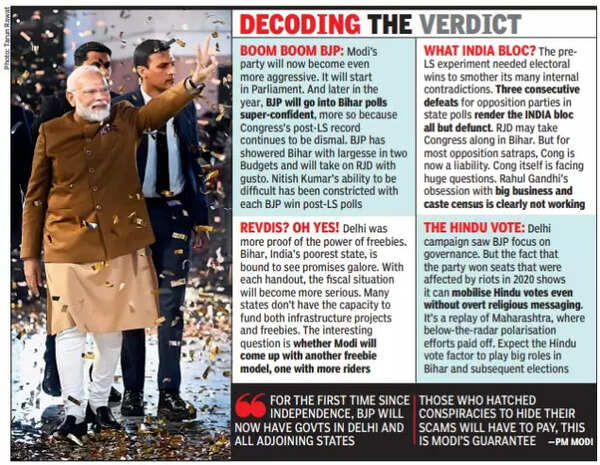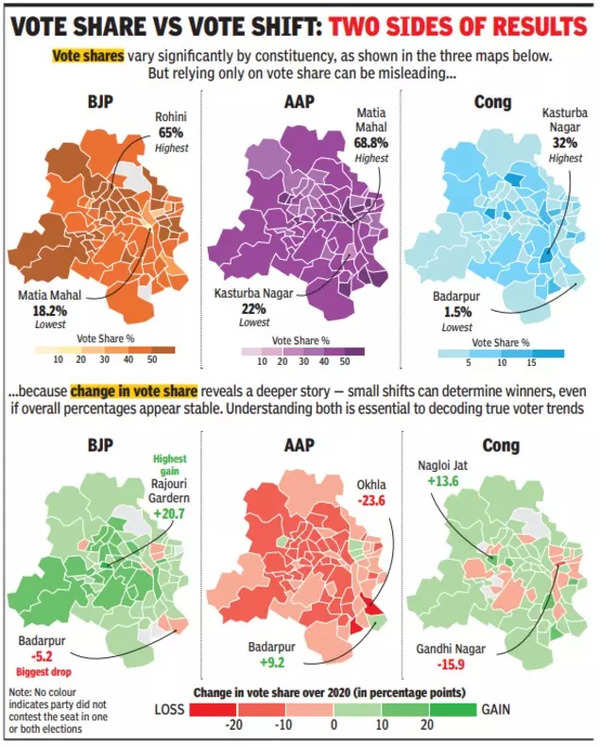Delhi’s is among the smallest of many elections held in the world’s largest democracy – but on Saturday, the national capital sent out some massive national political messages.
First, BJP’s post-Lok Sabha elections loss of lustre is now a firmly closed chapter. Modi is back again as a political super-force and the most saleable political brand.
Second, following from the first, Rahul Gandhi is back to looking like he used to before Congress won 99 seats in Lok Sabha polls.
Delhi Election Results 2025
Nothing he does or says seems to matter when it comes to elections.
Third, Arvind Kejriwal’s status as a big national opposition player has, for now at least, been severely diminished. Seldom has a political brand taken as big a hit as his took after the Delhi results.
Fourth, the opposition alliance is now in tatters.
Fifth, at least in urban areas, freebies alone can’t win elections, as became clear via Delhi voters punishing AAP for bad infrastructure.

In Delhi, there was a sense of one era ending and another beginning in the city. BJP returned to office after 27 years, and AAP was voted out after a decade. Kejriwal will not return as Delhi CM, nor will Atishi. All eyes are on who Modi-Shah pick as BJP’s CM.
The last time BJP was voted to office in Delhi, in 1993, Yamuna still had aquatic life, Appu Ghar was the biggest city attraction, Delhi Metro looked like a distant dream, and city air wasn’t toxic. A city that has changed so radically, for good and bad, gave a verdict that was equally dramatic.
The sense of stunning change was heightened by Kejriwal losing the New Delhi seat. His 4,089-vote loss to Parvesh Verma, ex-BJP CM Sahib Singh Verma’s son, in a seat he’d won by 21,000-plus votes in 2020, capped an awful day for AAP’s brass.
Lotus bloom vs pehle AAP: It was a matter of 2% points
How Delhi apportioned its votes was an interesting story by itself. BJP’s 48-seat haul in the 70-seat assembly came on the back of a 45.6% vote share. AAP’s 22-seat tally, less than half of BJP’s, was coupled with a substantial 43.6% vote share.
That a 2-percentage point difference in vote share could change fortunes so comprehensively said five things.
First, this is the first time ever that a party with a 40%-plus vote share in Delhi has lost elections. Second, the 10-percentage point fall in AAP’s vote share between 2020 and 2025 didn’t erode its low-income voter base substantially.

Therefore, third, middle class Delhi voters swung against the party and made a pivotal difference to the results.
Fourth, middle class anger against AAP was centred around the party’s seemingly uncaring attitude towards city infrastructure, an anger AAP either missed or downplayed.
Fifth, at the margins, that AAP and Congress fought separately and waged a bitter campaign against each other, made some crucial difference to the overall outcome.
Breaking up the verdict by Delhi sub-regions shows just how far-reaching BJP’s victory is. Its wins largely came from the outer Delhi areas bordering Haryana in north and west, and from New Delhi and East Delhi. BJP won nine of 10 seats in the West Delhi parliamentary constituency area, eight each in North West Delhi and East Delhi, and seven in New Delhi. In the 2020 polls, BJP had failed to win a single seat in West Delhi and New Delhi, while it had emerged victorious in one seat in North West Delhi. It also won six seats in Chandni Chowk Lok Sabha area, where it had no legislators in the last term.
Plus, BJP also managed to make inroads in Dalit-dominated areas, winning four of the 12 reserved SC constituencies. Capping all this was the party wresting the Muslim-dominated seat of Mustafabad, where it benefitted from a four-cornered fight.
